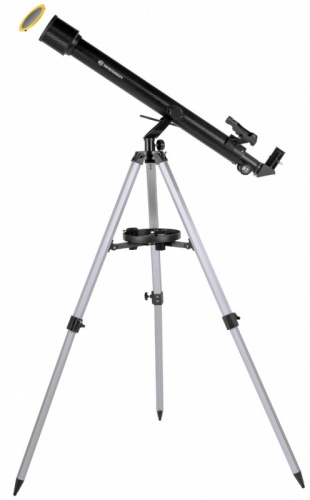Exploring our solar system: the starter telescope with extensive accessories shows you the Sun, Moon and planets at their best.
Complete set of telescope, tripod, mount and accessories
Easy to use refracting telescope for beginners
Telescope aperture: 60 mm / focal length: 800 mm
Ideal for observation of Sun, Moon and planets
Includes smartphone adapter for first steps in astrophotography
Plenty of accessories to get started right away
With safe aperture solar filter
Simply set up and explore the Moon, Venus and co. straight away: With the BRESSER Stellar 60/800 AZ lens telescope, getting started in sky observation is quick and easy. The complete set already contains the necessary equipment for your new hobby: the astronomical lens telescope with 60 mm aperture and 800 mm focal length, the azimuthal mount, the tripod and extensive accessories for your voyage of discovery through the solar system. The beginner's telescope is very easy to use and therefore ideal for getting children excited about astronomy.
Well-tried classic for completely new impressions - the telescope
Especially for beginners and children, this classic lens telescope - also known as an achromatic refractor of the Fraunhofer type - makes it easy to enjoy astronomical sights. The modern, precisely coated optics ensure good imaging properties. Another strength of the optics: the 60 mm aperture and the 800 mm focal length result in a very large focal ratio (ratio of the aperture to the focal length) of about 1 to 13.3 (F/13.3). The result: a very sharp image with good contrast. The long focal length also makes the telescope a specialist for lunar, solar and planetary observation. However, open star clusters and globular clusters are also guaranteed to amaze you when you look through the telescope.
And how big do the celestial objects appear? With the aperture size, the starter telescope achieves a resolving power which lets you enjoy really sharp images at up to 120x magnification. Technically, this entry-level telescope is capable of more - theoretically up to 600x with the included accessories. But: with increasing magnification, the image sharpness can slowly decrease. Of course, not only the telescope plays a role when it comes to magnification. The air turbulence in the atmosphere (seeing conditions) also affects your view of the night sky.
The foundation for your view into space - mount and tripod
The telescope tube is held securely on the height-adjustable aluminium tripod with azimuthal mount. And this azimuthal mount has a great advantage: it is very easy to operate. Just like a common photo tripod, you simply swing the telescope manually to the left and right, up and down. Perfect for beginners in astronomy and children. But where to put the accessories? To keep them within easy reach, just place eyepieces, solar filter etc. on the storage plate between the tripod legs.
All you need for a quick start in astronomy - the accessories
For your fascinating view of the night sky, the telescope for beginners comes with lots of accessories. Among them you will find a LED-viewfinder, with which you can easily keep track of the sky. It is mounted parallel to the actual telescope and projects a red dot onto a small screen. When you look through the viewfinder, the red dot appears to float in front of the sky - right where your starter telescope aperture is pointing. This way, the finder helps you to align your optics precisely and locate celestial objects - before you then take a closer look through the magnification of the telescope.
You determine how much magnification you get by choosing the eyepiece. You will see: The two eyepieces (4 mm, 20 mm) included in the set alone offer quite different perspectives on the beauties of our cosmos. For the most versatile views possible, the socket diameter of 1.25 inch (31.7 mm) also complies with an international, manufacturer-independent standard. So if you want to expand your astronomy set later, you will have a wide choice of models.
You have found an astronomical highlight and want to see even more details? Then place the 3x Barlow-lens between the telescope and the eyepiece. It will triple the magnification.
Meanwhile the included 90-degree star diagonal mirror lets you comfortably admire the night sky. Even though your entry-level telescope is pointed upwards, you don't have to lie down underneath to enjoy the view. Instead, you look in comfortably from the side.
But it is not only at night that we can observe the beauty of outer space. During the day, our own Sun is the undisputed star in the sky. So attach the solar filter to the aperture of your beginner’s telescope and safely observe sunspots and granulation.
CAUTION: Never point the telescope at the Sun without the solar filter!
To capture and share your unforgettable moments in astronomy, take your very own snapshots with the smartphone adapter. Thus the very first step towards astrophotography is easily taken!
Look forward to your complete astronomical starter package and a whole new view of the Sun, Moon and planets - with the BRESSER Stellar 60/800 AZ lens telescope.
FEATURES
Beginner’s telescope for astronomy
60 mm aperture and 800 mm focal length
Achromatic refractor type Fraunhofer
Ideal for observing the Sun, Moon and planets
Height-adjustable tripod with azimuthal mount
Easy to use, therefore suitable for children
Focal ratio F/13.3, therefore very sharp image and high contrast
Two eyepieces and one Barlow-lens with 31.7 mm (1.25 inch) sockets for different magnifications
Safe solar observation with the included solar filter
Entry into astrophotography with smartphone camera adapter
SCOPE OF DELIVERY
Starter lens telescope
Aluminium tripod
Azimuthal mount
Eyepieces: 4 mm and 20 mm (1.25 inch sockets)
Barlow-lens 3x (1.25 inch sleeve)
Star diagonal mirror
LED red dot finder
Solar filter
Smartphone camera adapter
Accessory tray
Astronomy software via download
Instruction manual





















 Fast & Reliable Delivery
Fast & Reliable Delivery Helpful & Friendly Staff
Helpful & Friendly Staff Best Prices Online
Best Prices Online 100% Secure Shopping
100% Secure Shopping